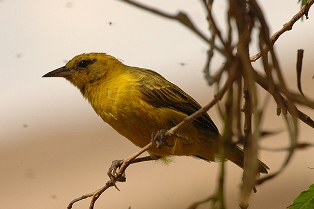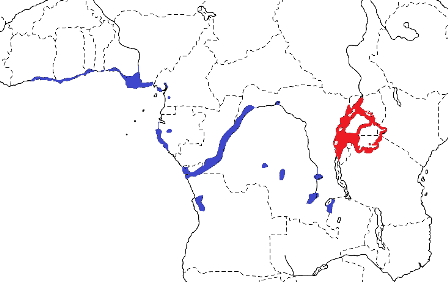Weaver Wednesday [41]: Slender-billed Weaver 2013-03-27 (346)
 Weaver Wednesday
Weaver Wednesday


The Slender-billed Weaver Ploceus pelzelni is a small weaver with a large black mask from the forecrown through the face to the throat, ending in a point on the breast (see photo far right). The female lacks the black and has the top of the head green and a black bill (see photo right). The juvenile is similar to the female but duller and with a pale bill. The slender bill and swamp habitat distinguish it in all stages from the similar Little Weaver P. luteolus, a savanna species with a thicker bill. The ranges of these two similar species are disjoint in West Africa, but overlap around Lake Victoria.

Two subspecies of the Slender-billed Weaver are recognised (see map left, based on Birds of Africa):
P. p. pelzelni, in NE DRC, Uganda, SW Kenya, Rwanda, Burundi, and NW Tanzania (see red on map).
P. p. monacha, in W Africa from Ivory Coast to Cameroon, and Gabon, Congo, W and S DRC, NW Angola, and NW Zambia (see blue on map). The bill is shorter and less slender than in the nominate subspecies.
The Slender-billed Weaver is restricted to wetland areas for breeding, foraging in trees and bushes in adjoining habitats. In western Africa it inhabits mangroves, coastal lagoons, marshlands and ricefields. In southern DRC it occurs in ambatch thickets bordering lakes, and also in gardens and hedges in urban areas. It usually occurs below 1700 m but up to 2350 m in the Ruwenzoris. The Slender-billed Weaver is found singly or in pairs or in flocks.
It feeds mainly on insects, including small caterpillars and ants. Seeds have also been recorded. It forages at all levels in trees. It is agile and often hangs upside down when foraging. The foot structure shows adaptations to a papyrus habitat.
The Slender-billed Weaver is a monogamous, colonial nester. Colonies are usually in groups of less than 20 nests, but sometimes up to 50, or single nests at about 12 m apart. It may breed alongside mixed colonies of other weaver species. The nest is ball-shaped, tightly woven, without an entrance tunnel or with a very short tunnel, with a porch over the side-top entrance. The nest is made of grass strips or papyrus leaf, and some nests include dead pieces of vine stem. There is no ceiling as in the nests of some weavers. During incubation a sparse lining of very fine strips of grass, palm leaves, feathers or seed-heads may be added.



The nest is attached to papyrus heads, or in trees (thorny twigs or small palms) at a height of 1.5-9m (usually about 3m) above the ground. The nest is built by the male, with the female sometimes helping. Sometimes two nests are built on the same stem, but only one is occupied.
Clutch size is 2-3. The eggs are pure white or sometimes pinkish, rarely with fine spots. In Kisangani it breeds all year, but peaks in September. It is parasitized by cuckoos, most likely the Diderick Cuckoo Chrysococcyx caprius. Nests have been robbed by Pied Crows Corvus alba and Senegal Coucals Centropus senegalensis.
The Slender-billed Weaver has 8 PHOWN records, representing both subspecies, but many more PHOWN records are needed for this species (see PHOWN summary). Also look at old nests which may be used by Dusky-blue Flycatchers Muscicapa comitata. Submit any weaver nest records to PHOWN (PHOtos of Weaver Nests) via the Virtual Museum upload site.
PHOWN summary
Previous Wedn: Southern Red Bishop
Full weaver species list
|


 Weaver Watch
Weaver Watch


